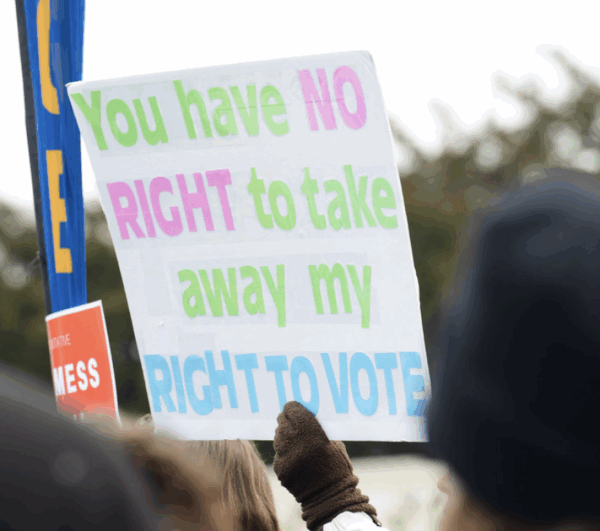The Continuing Problem Of Vote Suppression In America
America is at an interesting historical juncture. An African American may well be elected president in a few weeks. From the 1600s to 1865 black slavery in this country was sanctioned by law. From the end of Reconstruction until 1965, a significant proportion of blacks in the South could not vote. Passage of the Civil Rights Act of 1964 and the Voting Rights Act of 1965 - acts signed by a Democratic president, supported in Congress by most Republicans and most northern Democrats and strongly resisted by most southern Democrats - led soon thereafter to a historic shift in party allegiance, in which the "party of Lincoln" adopted the so-called "southern strategy" of appealing to the racism of white southern Democrats, thereby driving blacks into the national Democratic Party. (It's worth noting that an average of only 51% of blacks nationally in 1952, 1956, and 1960 identified themselves as Democrats.)
It remained for a young campaign worker in Richard Nixon's 1968 campaign, Kevin Phillips, to write a book the following year, The Emerging Republican Majority, called by Newsweek "the political bible of the Nixon era," in which Phillips argued, "the GOP can build a winning coalition without Negro votes. Indeed, Negro-Democratic mutual identification was a major source of Democratic loss [in 1968]." The southern strategy continued to be openly employed in Republican presidential campaigns as late as 1988, and more subtely in succeeding elections.
What Republicans have used in tandem with appeals to white racism is a variety of vote-suppression techniques targeted at blacks, Latinos, and the poor in general, all of whom tend to vote Democratic - blacks most heavily, at around 90%.
It is my view that racism has gradually declined in the electorate, however, and that the racial targeting of modern Republican vote-suppression efforts is probably less the result of racism pure and simple than the fact that blacks, and to a lesser extent, Latinos, are simply vulnerable partisan enemies to be disfranchised. But for whatever motive, these two groups continue to be subject to disfranchising efforts with deep historical reverberations. I will mention briefly two major techniques: vote caging and photo ID laws, although several other forms have been used over the years and are, indeed, being used this year.
I define vote caging as a process in which political operatives 1) typically send "do-not-forward" letters to registered voters of another party; 2) make a list of the names of those persons whose letters are returned unopened; and 3) try to use this "caging list" either to challenge those persons if they appear in the election precinct at which they are officially registered - the assumption being that they have changed their residence and are therefore not entitled to vote in their former precinct. Vote caging incidents typically involve letters sent disproportionally to black, Latino, and poor neighborhoods.
There are several reasons a do-not-forward letter may be returned: unreliable mail delivery in high-poverty neighborhoods, addressees who are Armed Forces personnel who are overseas, typographical errors by party operatives, or refusal of those in charge of homeless shelters to deliver mail to residents.
A recent study lists nine reasons why returned do-not-forward letters can lead to a false inference that the challenged voter is not qualified to vote. That vote caging is not simply a "good-government" nonpartisan effort to ensure fair elections is obvious from the fact that the letters are targeted to members of another party. Another problem is that challenges at the polls slow the voting process, and if the lines outside the voting booth are long, many of those in line - also from the neighborhoods targeted by the cagers - may become discouraged and leave.
In a report written in 2004, three historians and I, using standard scholarly sources, identified a number of cases of vote caging since World War II which either resulted in legitimate voters being prevented from voting or were brought to light before Election Day and enjoined from proceeding. Here is a sample of our findings.
- A series of caging incidents occurred in black and Latino precincts in Phoenix, Arizona, during the 1950s and 1960s. Republican operatives, primarily lawyers, were involved, although there was at least one case of Democrats responding to these operations by targeting Republican precincts. Concomitant with the caging were intimidation of minority voters, scuffles between challengers and voters, and failure of the challengers to comply with the law governing Election Day procedures. These incidents in Phoenix received nationwide attention in 1971 and 1986 when senatorial hearings were held on the confirmation of William Rehnquist to the Supreme Court and then as chief justice, inasmuch as Rehnquist, a young lawyer in the early 1960s, had played an important role in his party's caging efforts directed toward minority voters.
- The nationwide ballot-security program mounted by the Republican National Committee in conjunction with the 1964 election, called "Operation Eagle Eye," printed training materials recommending the use of do-not-forward letters in order to compile voter challenge lists.
- A particularly noteworthy instance of caging occurred in the 1981 New Jersey gubernatorial election. In addition, operatives of the Republican National Committee sent off-duty law enforcement officials to the polls and put posters in heavily black neighborhoods warning that violating election laws was a crime. This led to a consent decree in the court of Federal Judge Dickinson R. Debevoise prohibiting the Republican National Committee (and the Democratic National Committee as well, although it was not implicated) from engaging in some of the more egregious forms of vote suppression, including racial targeting.
- In 1986, a caging effort by Republicans in a Louisiana senatorial race was enjoined by a federal judge, which led to the RNC being required to appear before Judge Debevoise once again and agree to submit all its future ballot security programs to his court for approval - an agreement still in effect today. There was ample evidence that the Louisiana caging was racially targeted. A Republican operative wrote to a co-worker while the effort was under way, "I would guess that this program will eliminate at least 60-80,000 folks from the rolls. . . . If it's a close race . . . which I'm assuming it is, this could keep the black vote down considerably."
- In the 1990 North Carolina general election contest between U.S. Senator Jesse Helms and his African-American challenger, Harvey Gantt, the state Republican apparatus in conjunction with the Helms campaign sent out two mailings of postcards containing false and threatening information. The first (81,000 cards) was sent to precincts in which 94% of the voters were black, and the second (44,000 cards) was sent exclusively to black voters. The Gantt campaign reported instances in which biracial couples received cards addressed only to the black member of the family. One purpose of both mailings was to obtain a list of black registrants whose cards were returned as undeliverable, in order to challenge them at the polls - a plan that was frustrated at the last minute by Justice Department intervention.
The Brennan Center for Justice has recently published a chronological account of vote caging from the early years in Arizona mentioned above to five instances in 2004 in Ohio, Nevada, Pennsylvania, Florida, and Wisconsin. Other actual or intended voter challenges in 2002 or later, which may have involved caging lists derived from techniques other than direct mail, are mentioned by attorney Teresa James in a recent publication by Project Vote. She documents instances in Wisconsin in 2002 and 2004; North Carolina, South Carolina, Georgia, and Kentucky in 2004; Washington state in 2005; and New York in 2006. James asserts that in 2004, political operatives targeted more than half a million voters in caging campaigns. There is evidence that Republican vote caging efforts are being widely employed this year as well. One alleged effort in Macomb County, Michigan, in which caging lists were to be compiled by Republicans based on people whose home mortgages had been foreclosed - was denied by party officials when a local on-line newspaper quoted the party chair to that effect. The chair himself denied having made the statement. A lawsuit has been filed by the DNC and the Obama campaign to enjoin such behavior. Its outcome is still pending.
A second vote suppression tactic involves the passage of photo ID laws which typically narrow the kinds of ID voters are required to submit at the polls. These laws are particularly worth discussing here because they ostensibly address a problem which Republicans claim vote caging addresses as well: Democratic voter fraud. In the case of vote caging, the fraud is said to inhere in voters failing to re-register when they change their place of residence. In the case of a photo ID requirement, the fraud is said to involve illegal impersonation of others at the polls.
The Indiana legislature passed such a law in 2005. It was one of at least ten legislatures between 2005 and 2007 to vote on a photo ID bill. The votes were highly partisan in these ten cases: 95.3 percent of the 1,222 Republicans voting and just 2.1 percent of the 796 Democrats voting supported the ten bills. The Indiana law - one of the most restrictive photo ID laws in the nation - was challenged as unconstitutional, and the U. S. Supreme Court this spring in Crawford v. Marion County Election Board ruled 5/4 in favor of Indiana, holding that the plaintiffs had not shown the law had a disfranchising effect. However, it was stipulated that not a single case of voter impersonation at the polls was known to exist in the history of the state - a fact which a lower court judge attributed to lax law enforcement.
Greg Abbott, the attorney general of my own state of Texas, signed an amici curiae brief with several other state attorneys general supporting Indiana in the case, warning about the dangers of voter impersonation fraud. Abbott's action must be placed in the context of the hard-fought efforts of Republicans in both the 2005 and 2007 sessions of the Texas legislature which came close to passing a photo ID bill. After their first failure to do so, Mr. Abbott announced in January 2006 a million-and-a-half-dollar initiative to quell what he called Texas' vote fraud "epidemic." It was the largest such initiative in the state's history, led by a Special Investigations Unit that would, in Abbott's words, "help police departments, sheriffs' offices, and district and county attorneys successfully identify, investigate and prosecute various types of voter fraud offenses."
Texas is a large state, with thousands of elections occurring in a four-year period in its numerous governmental units. In 2006, there were 13.1 million citizens registered to vote. In addition, by one estimate, 1.7 million Texas residents were undocumented.
In October 2007, shortly before the Supreme Court heard the Indiana case, a tally was made of all the election offenses Mr. Abbott had uncovered in the almost two years since he first announced his vote fraud initiative, during which 4.4 million Texans had voted in the general elections for governor or U.S. Senator, in addition to those who voted in the primaries.
Thirteen persons had either been indicted, found guilty, or sentenced for vote fraud of any kind. Of these, 4 were accused before 2006, and the remaining 9 in 2006. Six of the 13 had not yet been tried. Moreover, of the 7 found guilty and the 6 remaining under indictment, none of the types of fraud they had been charged with involved voter impersonation and thus would have been prevented by a photo ID law.
This is a good place to point to a distinction often lost on those who favor such a law: "vote fraud" of virtually any kind - whether involving registration fraud, vote buying, computer hacking, or illegal purging - and "voter fraud," the most notorious of which is voter impersonation at the polls. Attorney General Abbott's findings regarding voter fraud is in line with every academic study of such fraud in the last decade of which I am aware. This fact, I suspect, is widely understood by Republican legislators who support photo ID laws, as is the fact that Democrats - and particularly African Americans, Latinos, the elderly, and poor citizens - are far less likely to have government-issued photo IDs than others.
At the time I was born, in Texas, the state still had a poll tax costing about $11 in today's dollars, and an all-white Democratic primary, at a time when nomination to an office in that party was tantamount to election. When I was in graduate school President Lyndon Johnson signed the Voting Rights Act and confided to his aide Bill Moyers that he believed his doing so would lead the Democrats to lose the South for at least a generation. He was correct; and indeed, since 1964 no Democratic presidential candidate has ever been able to garner as much as 50% of the white vote nationwide. But change is in the air. I am pleased to have lived long enough to see an African American nominated to the presidency. This, in my view, is a breathtaking leap forward in our nation's journey to overcome its long racist legacy, for which both parties are responsible. And one day, perhaps, we will even witness the end of race-based vote suppression tactics. When that happens, at least in the world of politics, we will truly have overcome.
Stay informed
Sign up to be the first to hear about how to take action.
By completing this form, I agree to receive occasional emails per the terms of the ACLU's privacy statement.
By completing this form, I agree to receive occasional emails per the terms of the ACLU's privacy statement.



